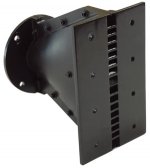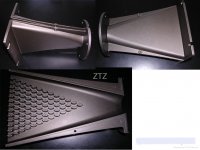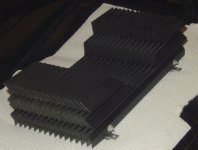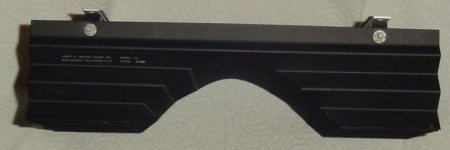These are becoming popular with pro sound line arrays. A multipath waveguide couples one driver to a line exit with equal length paths.
Equal areas but different exit shapes. The goal is to prevent extra delay time to the ends vs. the middle.
David S
Equal areas but different exit shapes. The goal is to prevent extra delay time to the ends vs. the middle.
David S
Attachments
Those would be 'exemplary' waveguides acccording
to definitions given in this thread ... and can also be
attached to a horn ...
to definitions given in this thread ... and can also be
attached to a horn ...
I'm not aware of that EV, JBL etc have been marketing their constant directivity horns as "waveguides" back then (sure, now its different - as marketing "waveguides" simply is hip nowadays).
My observation is that its definitely been Earl who has started out in popularizing "waveguides" in his papers, in his patents and in this forum, which he - also - deliberately and outspoken entered for commercial reasons first hand (any need to set some links?)
😉
Do I "blame" him ? - don't think so - I just state the obvious for those having difficulties to summarize over long time periods - but I'm all ears should it be otherwise.
Michael
My observation is that its definitely been Earl who has started out in popularizing "waveguides" in his papers, in his patents and in this forum, which he - also - deliberately and outspoken entered for commercial reasons first hand (any need to set some links?)
😉
Do I "blame" him ? - don't think so - I just state the obvious for those having difficulties to summarize over long time periods - but I'm all ears should it be otherwise.
Michael
I don't think it is right to "blame" Earl for the use (or misuse) of the waveguide term. With all the CD horn development in the 80s and later, it was already becoming a popular euphemism for horns designed with a priority placed on polars or d.i.
David S.
As stated, "waveguide" sounds cool, so before long everyone renamed their devices "waveguides".
Last edited:
...
My observation is that its definitely been Earl who has started out in popularizing "waveguides" in his papers, in his patents and in this forum, which he - also - deliberately and outspoken entered for commercial reasons first hand (any need to set some links?)
😉
...
http://www.microwaveengservices.com/waveguide sections.jpg
Waveguide (acoustics) - Wikipedia, the free encyclopedia
Waveguide - Wikipedia, the free encyclopedia
---
Seems like the traditional meaning of the term is restricted to structures
having "transmissionline" properties.
A transformer or radiator functionality due to change in cross sectional
area seems not to be implied with the term and it's current accepted use.
I am neither able nor authorized to nor interested in judging about the
term's proper use but i want one thing to be made clear from a
pragmatical/linguistical point of view:
1. The first person, who uses a term outside a traditional meaning
does not necessarily change the definition of the term.
2. Even if the person may give a well (or even better) defined
(new or modified) meaning, it is only a proposal to the language
community.
3. That conservative "inertia" is a major property of any language,
enabling it to serve as a common symbol inventory for a longer period
of time. It is inherent to any language as well as changes are.
4. Change in common definitions is decided by the majority of a
language community. ( Which dependent from time and location
may be the majority of the subset of the community having weapons.)
5. It is the task of e.g. encyclopedia, science media, public curricula
to decide, whether changes in common use of a term justify a change
in definition.
---
As long as i am not working or publishing myself on "waveguides", i have
to stick with common definitions. That means my references are e.g.
common encyclopedia, common textbooks on acoustics or RF techology.
Kind Regards
Last edited:
I'm not aware of that EV, JBL etc have been marketing their constant directivity horns as "waveguides" back then (sure, now its different - as marketing "waveguides" simply is hip nowadays).
Hello migeO
JBL used the term "Waveguide" going back to the LSR Series from the middle 90's. They then went on to the PT Waveguides in the AE Series. They still make Bi-Radial Horns and make a point of differentiating between them and waveguides and use them in their TOTL Commercial speakers. They being the Everest 2, the K2 Series 9900, 9800 and the Array Series.
All the PT's are used in commercial JBL Pro SR boxes but having used them they can sound just fine at home.
Hello David
My personal favorite are the serpentines. The look great😀 and seem to work OK as well. I will link the paper on them from the Lansing Heritage site for anyone interested. Here's a picture of the smallest serpentine to get a better fell for how they work. I use them on my 4344's.
ACOUSTICAL LENS
Rob🙂
Attachments
[I am neither able nor authorized to nor interested in judging about the
term's proper use but i want one thing to be made clear from a
pragmatical/linguistical point of view:
Kind Regards
Oliver
I completely concur with your analysis and I admit that popular usage has made the term "waveguide" mean almost everything and anything. I made my statements as a poiunt of historical fact. It is very true that I have used the term ever since in the context for which I originally intended it and in many ways I "popularized it". But, as you correctly point out, the usage by others virtually never coincided with my usage and as such the term is now virtually synonimous with the term "horn" and then some. Basically it has no meaning in this context anymore. But at one point in time it did.
JBL, EV, etc. - none of them used "Acoustic Waveguide" or "Waveguide" to define their products prior to my usage in 1991 ( remember that is nearly 20 years ago). In fact, working with John Eargle, JBL first licensed my ideas and paid for the earliest patent and trademark applications for "Waveguides". Both of these were later terminated due to a conflict of interest between my employer at the time Ford Motor and JBL. This work was all my own, not Fords, but I was working on Ford/JBL Audio systems. This made the whole relationship problematic.
So, I as I say, go ahead and use the term however you like, it has lost all meaning anyway. But just remember that there is a history here and that at one time it did mean something. And please, don't criticize me for continuing to use in the manner in which I first used it.
JBL used the term "Waveguide" going back to the LSR Series from the middle 90's. Rob🙂
Which, as I have pointed out, is after I had used the term in my context.
Which, as I have pointed out, is after I had used the term in my context.
Hello Earl
Yes I agree no disputing the timeline. I was just pointing out that the use of the term "Waveguides", for JBL at least, goes back to more than just a few short years ago. Time certainly does fly!
Rob🙂
Good to hear you summarize this way - though it might not have been the wisest choice to take "waveguide" for what you wanted people to focus on - but anyway - its like it is now - pretty much a mess
Michael
Michael
So, I as I say, go ahead and use the term however you like, it has lost all meaning anyway. But just remember that there is a history here and that at one time it did mean something. And please, don't criticize me for continuing to use in the manner in which I first used it.
it might not have been the wisest choice to take "waveguide" for what you wanted people to focus on - but anyway - its like it is now - pretty much a mess
Michael
Perhaps that is true, but twenty years ago it was an obscure word that no audio person ever used, only RF people (for an exactly analogous situation). It fit the application, seemed to be unused in audio, and had a nice ring to it. That it has become "a mess" there is no doubt, but certainly NOT due to anything that I did. All I ever tried to do was clear it up, but alas that is not to be.
re: John E. Karlson , his open end waveguide antenna appeared in the 1965 2-way "X15" speaker. (IMO it works very well)
here's a recent 8" coupler by Carl Neuser with that type of tweeter
A few examples of what might be called "K-tube" or HF K-coupler
J.E. Karlson Open End Waveguide Antenna patent
OPEN END WAVEGUIDE ANTENNA - Google Patent Search
here's a recent 8" coupler by Carl Neuser with that type of tweeter
An externally hosted image should be here but it was not working when we last tested it.
A few examples of what might be called "K-tube" or HF K-coupler
An externally hosted image should be here but it was not working when we last tested it.
J.E. Karlson Open End Waveguide Antenna patent
OPEN END WAVEGUIDE ANTENNA - Google Patent Search
Oliver
I completely concur with your analysis and I admit that popular usage has made the term "waveguide" mean almost everything and anything. I made my statements as a poiunt of historical fact. It is very true that I have used the term ever since in the context for which I originally intended it and in many ways I "popularized it". But, as you correctly point out, the usage by others virtually never coincided with my usage and as such the term is now virtually synonimous with the term "horn" and then some. Basically it has no meaning in this context anymore. But at one point in time it did.
Perhaps you ought to refer to your product as an "OS horn" from now on, and avoid -- or rather try to minimize -- the noise from all the naybobs that like to spend their time arguing with a sign post.
Freddi -
Thanks. Well.. that should help clarify who has "bragging rights" about serious inventions of waveguides, hornwavers, directionguides, and guidelenses.
Thanks. Well.. that should help clarify who has "bragging rights" about serious inventions of waveguides, hornwavers, directionguides, and guidelenses.
rA few examples of what might be called "K-tube" or HF K-coupler
That image gives a whole new meaning to the term "audio porn." 😀
se
Sorry guys, Karlson may have been a brilliant microwave inventor but the Karlson bass cabinet was pure snake oil.
David S.
David S.
here's a new unabused Yorkville USC1 vs a simple and unoptimized Karlson-type coupler about the size of the original 1951 Karlson. K15's vent position and front shelf board have less dip than my coupler
USC1 vs K-box 20vrms/50Hz - 20dB more H2 for the pipehorn
34Hz USC1 vs K-box
K15 vs a reflex the same size of its rear chamber and tuning - 2 tone
~10 dB less sidebands for the Karlson than the reflex
USC1 vs K-box 20vrms/50Hz - 20dB more H2 for the pipehorn
An externally hosted image should be here but it was not working when we last tested it.
34Hz USC1 vs K-box
An externally hosted image should be here but it was not working when we last tested it.
K15 vs a reflex the same size of its rear chamber and tuning - 2 tone
~10 dB less sidebands for the Karlson than the reflex
An externally hosted image should be here but it was not working when we last tested it.
Sorry guys, Karlson may have been a brilliant microwave inventor but the Karlson bass cabinet was pure snake oil.
David S.
Here's a variation on a Karlson bass cab that works great.
YouTube - T15 Bass Bin based on Metro Audio's E-Array System
Sorry guys, Karlson may have been a brilliant microwave inventor but the Karlson bass cabinet was pure snake oil.
David S.
David
I see from your profile that you worked for the BBC.
Let me ask you:
1) Is Tom Danley's tapped horn snake oil? If I remember correctly there was here on DIYaudio a collaberative effort to make one.
2) Ron Clarke mentioned the shape of the baffle had a large impact on getting a spherical wave. Do you think the Frugal Horn II and III curved opening and the Austin A127 and A166 curved openings are rubbish and do not work?
3) If I remember correctly the BBC had the "BBC slot" that is used to get a wider dispersion which worked up to a maximum frequency depending on the width of the slot. Do you want to tell me that the BBC slot is a fake and rubbish?
4) Do you think the T15 mentioned just before does not work?
re 1) If you look at the impedance and SPL curve of the Tapped Horn and then at the impedance and SPL curve of the Karlson then they are pretty similar. In fact a tapped horn is a derivative of the Karlson but hey, everyone likes reinventing the wheel.
re 2) and re 3) Instead of a hollow curve like the Frugal Horn and Austin you may also curve it the other way. If you then flip the baffle over the driver so you get some compression then you get a wide range BBC slot at the same time (killing two birds with one stone)
re 4) It is a known fact that the Karlsons have more slam outdoors, Metallica used the Karlsons for their concerts. A famous recording studio used them. The T15 is just a Karlson with the top chamber bent 90 degrees backwards.
There has been a new design developped in collaberation between a number of people and it has been hailed as the best (midsized) Karlson yet. Have you listened to it?
No, ofcourse not, you are just prejudiced.
Don't bother replying because I am done here with you.
Link to the real T15
http://www.metroaudiosystems.gr/pages/manuals/E_Array_Manual_en.pdf
Mine is a clone.
http://www.metroaudiosystems.gr/pages/manuals/E_Array_Manual_en.pdf
Mine is a clone.
- Status
- Not open for further replies.
- Home
- Loudspeakers
- Multi-Way
- is this a horn or a waveguide?



